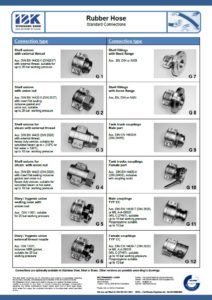Description
IBK Hose for Cooling Water Type 30.4401
Made in Germany
Description
- Developed for high-temperature load
- Ideal cooling water hose for use at blast furnace
- The plies of rubber, glass fiber and stainless steel provide a long service life and a high reliability under extreme operating conditions
- Highest resistance to radiant heat and flames, confirmed by TÜV NORD
Tube
- Black smooth extruded inner layer of EPDM
- Suitable for treaded and not treaded cooling water
- Electrically conductive (R < 10^6 Ω)
Reinforcement
- Braided reinforcement in stainless steel (1.4401 / AISI 316)
- Heat protection plies in braided glass fiber
- Several intermediate layers
Cover
- EPDM outer layer, black, antistatic (R < 10^6 Ω), fabric textured, flame retardant and self-extinguishing, resistant to abrasion, ozone, weather and high temperatures
Temperature resistance media
- Resistant: from – 40°C up to +160°C
- Resistant to hot steam for a short time to + 230°C
Electrical Properties
- Electrical resistance through the hose wall: R < 10^6 Ω
Safety Factor
- > 3-times working pressure
Technical Data
| Internal Diameter (mm) | Wall Thickness (mm) | Bending Radius | Working Pressure 20°C (bar) | Vacuum | Theoretical Weight (kg / m) | Length max. (m) |
|---|---|---|---|---|---|---|
| 19 | 10.0 | 95 | 120 | -0.5 | 1.42 | 40 |
| 25* | 7.0 | 125 | 60 | -0.5 | 1.05 | 40 |
| 25 | 10.0 | 125 | 100 | -0.5 | 1.78 | 40 |
| 32 | 10.0 | 160 | 80 | -0.5 | 2.06 | 40 |
| 40 | 10.0 | 200 | 68 | -0.5 | 2.42 | 40 |
| 50 | 10.0 | 250 | 62 | -0.5 | 2.88 | 40 |
| 65 | 10.0 | 325 | 48 | -0.5 | 3.62 | 40 |
| 75 | 10.0 | 375 | 38 | -0.5 | 4.19 | 40 |
| 100 | 10.0 | 500 | 25 | -0.5 | 5.31 | 40 |
| 125** | 12.0 | 625 | 16 | -0.5 | 7.16 | 10 |
** DN125: With 2xStainless Steel Braids and white EPDM cover
→ ATTENTION: The bending radius must not fall below the mentioned data! Not suitable for the assignment of torsion strengths
→ Other sizes and different s are available on request. Pictures might be different to the original.
Standard Connections
Our Rubber hoses are manufactured according to the customers’ request. Especially the connections play an important role. Further information for the different types of connections you can get here

